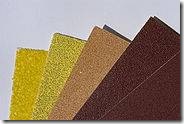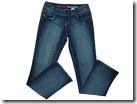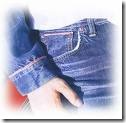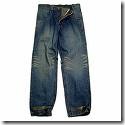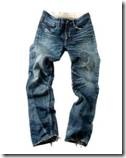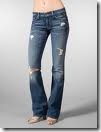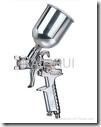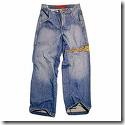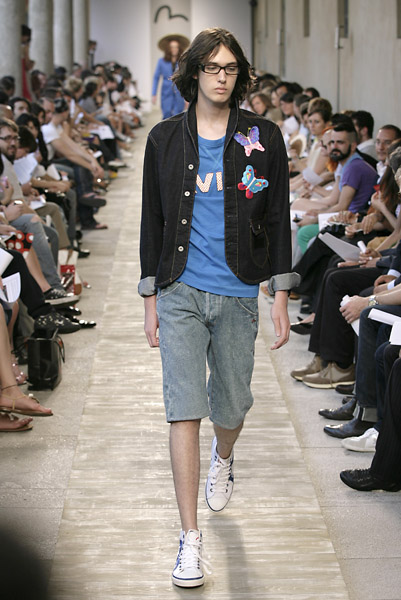The distressed jeans that we see around everywhere undergo a wide variety of wet as well as dry treatments to get the desired effects. Here I shall try to explain some basic Denim Dry Processing techniques. In the creation of vintage denim jeans, dry processes play a very important role and hence important to understand.
Denim Dry Processing – Basic know how
Destroying denims is as much an art as it is a technique. Details are added using a fine abrasive paper on a scraping tool. And extra whiskering can be added with sand paper. Sometimes a bit of local tint staining is being done into the local areas to emphasize the lighter parts. The jeans then go for a washing with pumice stone to blend in the whiskering and tinting / over dyeing. Where the folds and wrinkles go is where the art part comes in, it’s often through observation of where wear patterns are typically found. For some of mine I have several pairs of old well worn thrift store jeans that I use as a template to guide where I want the wear patterns. I chalk in where I want the details and then they are finished off site by me in my finish workshop. Some of what is done to customize jeans are patented secrets, no one other than those who work for these companies knows the exact techniques or the abrasives and chemicals used to achieve certain special effects. Here I am revealing some basic facts to the denimsandjeans.com readers……………..
Below is list of operations being carried out on denim garment to achieve VINTAGE (used/worn out) look……
- Hand Sand / Hand Scraping
- Sand blasting
- Whiskers
- Chevrons
- Knee Star / knee whiskers
- Hot Spot
- Tacking
- Grinding
- Damages / Destruction
- PP Spray
- PP Brush / towel
- Patch / repair
- Bleach spots
- Resin application
- Pigments & Local tint application etc…..
1.Denim Hand Sand / Scraping
Hand sand is step which is generally being done in rigid form of garments to get distress look. Locations can be front thigh & back seat or its can be overall / global application as per Standard. Emery paper is being used to scrape the garments in particular placement & design. Emery paper comes in different number generally start from 40 till 600 and above , higher the number finer the emery paper, lower the coarseness of the paper. In garment industry from 220 , 320 & 400 number papers are most popular & widely used.
Purpose of doing this process is make used worn out look to the garments.
The most important factor is to select right number of paper according to the fabric strength & intensity need. Feathering / merging white sanded part to dark blue area in such way that it should look natural & not artificial.
Scraping can be done on inflated rubber balloons for better effect ( horizontal or vertical its up to operators convenience ) , even it can done plain wooden board of garment size & hand pressure should be uniform in order to get better results.
Hand sanding must be started from intense part & feathering out on less intense part gradually. One garment must by done by one operator only to have balance intensity on both the legs.
2.Sand Blasting
This process is isolated now a days due to health hazards & buyers do not like the results of sandblast because its covers the characteristics of fabric. This process being done by using different kin d of sand blown to garments with air pressure to rub out the color.
3.Whiskers/ Moustaches , Chevron , Knee Star, Hot Spot
On Denim, whiskers / Mustaches , Chevrons are nothing but the worn out lines / impression generated by natural wearing on hip & thigh area. There are many designs & pattern available.
This is being done manually with help of sharp edge Emery paper rolled on fine wood stick or pasted on plastic material. Before starting execution placements & pattern must be marked on garments, this will help operator to execute the pattern right to match the aesthetics of garment.
Hot spots are heavy/intense area on thigh or knee which is made purposely to create used look & on knee area if any whiskers line are there, called knee star.
All above operations are carried out in width direction hence its appears intense than hand sand with less strokes, because hand sand is carried out in length direction.
4.Tacking & Grinding
Tacking: is a process which is being done by swift tag machine with the help of plastic or nylon tag pins in rigid form of garment to get very heavy contrast ( rigid & washed ) on waistband, bottom hems, back pocket & front pocket corners etc.. after completing wash cycle, it must be removed from garment before making softening.
Grinding: is being done on pocket edges & bottom hems edges by running against abrasion surface or stone to achieve worn out effect. Many different make of machines & pen grinding tools are available in the market which runs with pneumatic system.
5.Damages/Destruction
One of the most popular distressing effects currently , ‘Destruction’ is an art which make denim look unique & used. To make destruction pen type of stone tools being used in mid of wash process to apply on desired area. It can also be achieved by cutting it thru knife the warp yarns & keep the weft yarn as is to show white thread. Holes also can be made by cutting weft & warp yarns. These are all manual processes & every garment will look unique & different than others.
6.POTASSIUM PERMANGNATE SPRAY/RUB & BLEACH SPRAY
PP Spray is being done on denim garments to achieve local abraded area to appear whiter than back ground indigo color shade. This can be applied by spray gun or by towel dipped in to PP Solution & rubbed on desired area followed by neutralization in wet process. This process can be done in rigid after doing hand scrape or in the middle of the wash. Doing after enzyme or bleach cycle will give more natural & white effect that doing in rigid. There are many additives can be added in order to achieve desired intensity and look.
The same way bleach solution also can be spray or rubbed on the garments on desired area. But this process is very complicated & needs highly skilled operators to execute it followed by immediate neutralization.
There are many parameters needs to be taken into control for doing PP or Bleach spray…. Spray gun pressure, width of spray, flow & way of spraying.
Note:Safety of operators must be taken in to consideration and it must be ensured that he should wear mask, gloves & eye glasses etc…
7.Patch & Repairs along with Bleach Spots
These are totally manual processes to give uniqueness to Denim and to make it look VINTAGE.
First cut or damage the units intestinally to desired area & then make hand repairs or machine repair to look natural. Diluted bleach can be used to spot the desired area followed by neutralization in wet process.
These process are time consuming hence productivity is low & reproducibility is very difficult but similar aesthetics can be achieved.
When we talk about Vintage denim, every garment should look unique & not a photocopy !. These garments are sold at very high prices so customer should have a feeling of uniqueness & feeling different from others. Vintage denim are signature/ autograph of a brand & its image.
8.Resin Application( 3D Effect )
Resin ( Formaldehyde free ) being used for achieving 3D effect ( 3 Dimensional ), Rigid Look etc. This process can be done by spraying or dipping the garments in to Resin, Catalyst, Silicone & PU solution in right combination according to the fabric strength & desired effect needed.
After application of resin solution in right proportion, make manual designing as needed on the thigh, hip & back knee area to get 3Dimentional effect. After making it , it should be manually dried with hot press or hair dryer & then must be cured in oven at right temperature, time as mentioned in resin product manual.
If resin not cured properly , 3 D effect will not be permanent & can cause skin irritation/rashes to the wearer. Highly skilled operators needs to execute this process in order to get consistency & uniformity.
Whole garment can have crushed look by resin dip & crushed manually followed by oven curing. Silicone plays an important role in getting softer hand after oven.
Special streaky effect & Crackles also being done by applying resin on desired area followed by scraping & pp spray then neutralization.
9.Pigments & Local Tint ( Staining) Application
Need to choose right color of pigment or tint with binder or fixer to apply locally on denim to get vintage look. This process also needs an artist to execute it nicely to merge the tint with ground indigo color & should not look too artificial. Pigments & Local tint also can be applied through spray gun or rubbing on desired area of denim garment. After application its must be cured in order to have permanent effect on jean.
As we can see from all the dry denim processes mentioned above, they are mainly manual processes. The quality of the worker can make or break the garment. Hence , great care has to be given to select the right personnel for these jobs.



